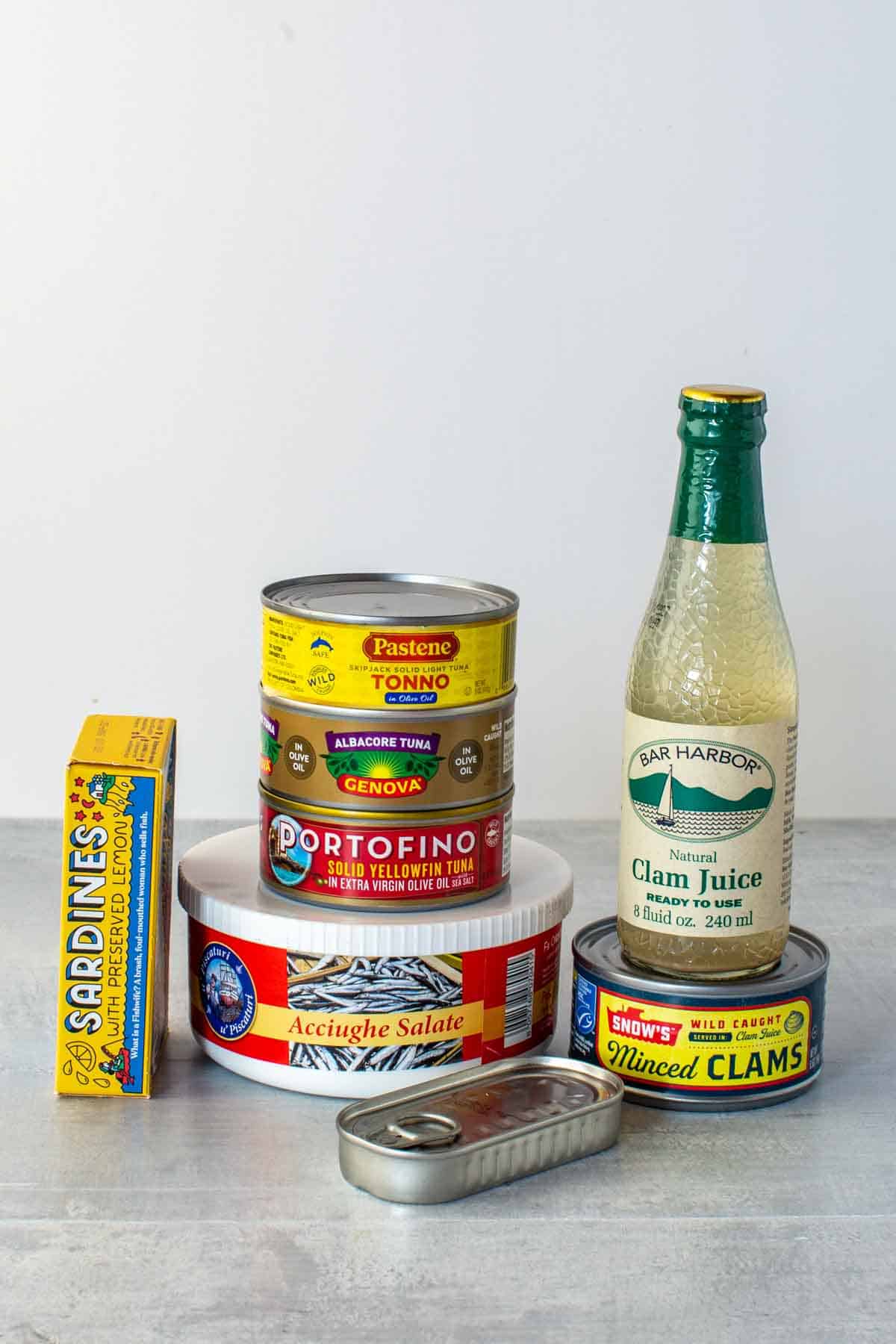Italian Tinned Fish and Seafood
Tinned fish and seafood are some of the most commonly used ingredients in Italian cuisine. From tuna to anchovies, these tinned and canned sea products are staples in many Italian households.
This post may contain affiliate links.

History and Culture
Italian cuisine is mostly based on simple dishes with widely available and cheap ingredients. The sea touches over 80% of the Italian borders, gifting the people with abundant seafood ingredients. During the centuries, they preserved these ingredients, to send them to mainland and use throughout the year.
The tradition of preserving fish and seafood in Italy dates back centuries, rooted in the necessity of prolonging the shelf life of the abundant Mediterranean catches. Ancient methods involved salting and sun-drying, which evolved into modern canning techniques in the 19th century. The development of the canning industry allowed Italians to enjoy seafood year-round, regardless of the season or location.
Types of Italian Tinned Seafood
- Canned Clams: Canned clams have a sweet, briny flavor and tender texture. You can use them in pasta dishes like Linguine alle Vongole. The high-quality Italian canned clams are usually packed in their natural juices or olive oil. While canned clams cannot compare to the taste of fresh ones, they're often used in mainland regions or when fresh clams are out of season.
- Bottled Clam Juice - Bottled clam juice is ideal for adding a salty, umami flavor to various seafood dishes and can often be used in place of fish stock or seafood stock. Look for it in the canned seafood aisle.
- Canned Tuna: Italian canned tuna, particularly the yellowfin tuna, has a firm texture and rich flavor. Tuna fish is abundant in the Mediterranean sea and it's mostly caught around the Sicilian coast. It's usually packed in olive oil or brine, and it is one of the most versatile ingredients, perfect for salads like this Italian Tuna Green Bean Salad, sandwiches, and pasta dishes. High-quality brands often label their tuna as "tonno in olio d'oliva," indicating it is preserved in premium olive oil.
- Canned Sardines: Sardines are small, oily fish that are packed with flavor and nutrients. Italian canned sardines are often preserved in olive oil, tomato sauce, or spicy marinades. They are great for eating straight out of the can, added to pizzas, or incorporated into pasta dishes for a robust, umami taste.
- Anchovies: Anchovies have a strong, savory flavor and are a key ingredient in many Italian recipes, from north to south. They are typically packed in olive oil or salt. Anchovies can add depth to classic dishes like Piedmont's Bagna Cauda, as a topping on Neapolitan-style pizza, and used in other dishes like these Roasted Brussels Sprouts with Anchovy Caper Butter.
- Other Canned Seafood: Italy also produces a variety of other canned seafood, including mackerel, mussels, and salmon. These are preserved in olive oil, brine, or flavored sauces.
Quality and Authenticity
Quality and authenticity are extremely important to Italians when it comes to their products. Authentic products guarantee that the seafood has been processed and preserved under stringent standards, maintaining its nutritional value and taste. Genuine Italian canned seafood comes from sustainable sources and it's often processed using traditional methods that have been passed down through generations.
Tips for Recognizing Authentic Italian Seafood
- Check for Certification Marks: Look for certifications such as DOP (Denominazione di Origine Protetta) and IGP (Indicazione Geografica Protetta) on the packaging. These labels indicate that the product meets high standards of quality and originates from specific regions in Italy known for their seafood. MSC (Marine Stewardship Council) certification is another important mark indicating that the seafood has been sourced sustainably.
- Read the Label Carefully: Authentic Italian canned seafood will often specify the region of origin, such as Sicily or Calabria. The label should also detail the type of fish, the method of preservation (in olive oil, brine, or sauce), and the absence of unnecessary additives or preservatives. Look for indications that the product is packed in Italy, not just imported from Italy.
- Examine the Packaging: High-quality Italian canned seafood is usually packaged in sturdy, non-rusty cans or glass jars. Glass jars are particularly telling as they allow you to see the product inside, which should appear fresh and well-preserved. Labels should be clear and professional, often indicating artisanal or traditional methods of preparation.
- Consider the Price: While price alone is not a definitive indicator of quality, be wary of products that are significantly cheaper than others. High-quality, authentic Italian canned seafood typically costs more due to the careful sourcing, preparation, and preservation processes involved.
- Research the Brand: Familiarize yourself with reputable Italian brands known for their canned seafood and mostly used by locals in Italy. Brands with a long history and good reputation are more likely to offer authentic and high-quality products. Look for reviews and recommendations online from trusted sources.
- Check for Freshness and Expiry Dates: Ensure the product has a clear expiry date, and that it is within the recommended shelf life. Authentic products will have a relatively recent production date, indicating freshness. Avoid cans that have dents, bulges, or rust, as these can indicate compromised quality and potential spoilage.
Uses in Italian Cuisine
Italian tinned fish and seafood are often underestimated and can bring the essence of Italian cuisine to your kitchen. Their rich flavors, versatility, and nutritional benefits make them a must-have in any pantry! Here are some of the most common uses.
Tuna and Mackerel
Canned tuna and mackerel are maybe the most popular canned seafood you can find. Tuna, especially, you can use in many different recipes, while mackerel is best on its own or with bread.
- Pasta sauces and pasta salads
- Tuna salad for sandwiches
- Salsa Tonnata for Pork
- Salads and Appetizers
Clams and Mussels
Jarred clams and mussels are very underestimated, and while they cannot compare to the fresh ones, they can add a delicious flavor to many seafood sauces and stews, even in addition to the fresh ones.
- Pasta sauces
- Stews like Cioppino
- Soups like Clam Chowder
- Seafood salads and Appetizers like Clams Oreganata
Sardines and Anchovies
They are both small fishes but with very different taste and uses. Sardines are usually canned in tins with olive oil or tomato sauces and are usually eaten on their own or with bread. Anchovies, instead, are usually jarred in salted olive oil. They have a strong flavor and they are the key ingredient in many Italian dishes:
- Pastas like this Pasta with Olives, Anchovies, Tomatoes + Breadcrumbs
- Pizza toppings - try them on a classic Neapolitan Pizza Margherita
- Salads and Appetizers
- Sauces and Dressings like for this Kale Caesar Salad
Storing Tips
Store in a Cool, Dark Place: Keep your tinned fish and seafood in a pantry or cupboard away from heat and direct sunlight.
Use by the Expiry Date: Check the expiration date and use the products within this period to ensure the best flavor and safety.
Refrigerate After Opening: Once opened, transfer any leftover to an airtight container and refrigerate for a few days.
FAQ
Once opened, transfer the contents to an airtight container and refrigerate, consuming within a few days for optimal freshness.
Yes, italian tinned fish and seafood is rich in protein, omega-3 fatty acids, vitamins, and minerals, supporting heart health, brain function, and overall well-being.
Canned tuna in olive oil is richer and more flavorful due to the olive oil, which adds depth and moisture. It is ideal for salads, antipasti, and straight from the can. Canned tuna in brine is lighter and lower in calories, making it suitable for recipes where you want a more neutral flavor or for mixing with other ingredients like in tuna salad.
Unopened canned seafood can be stored for several years, often up to 5 years, depending on the product and storage conditions. Always check the expiration date on the can, and store in a cool, dark place to maintain optimal quality.
Many Italian tinned seafood products come with certifications like MSC (Marine Stewardship Council), indicating sustainable fishing practices. Always look for these certifications to ensure that the seafood is sourced responsibly.
Some well-known brands of authentic Italian tinned seafood include Rio Mare, Callipo, Agostino Recca, and Ortiz. These brands are famous for their quality and adherence to traditional preservation methods.




